Kai Tang
Beyond Fixed Variables: Expanding-variate Time Series Forecasting via Flat Scheme and Spatio-temporal Focal Learning
Feb 21, 2025Abstract:Multivariate Time Series Forecasting (MTSF) has long been a key research focus. Traditionally, these studies assume a fixed number of variables, but in real-world applications, Cyber-Physical Systems often expand as new sensors are deployed, increasing variables in MTSF. In light of this, we introduce a novel task, Expanding-variate Time Series Forecasting (EVTSF). This task presents unique challenges, specifically (1) handling inconsistent data shapes caused by adding new variables, and (2) addressing imbalanced spatio-temporal learning, where expanding variables have limited observed data due to the necessity for timely operation. To address these challenges, we propose STEV, a flexible spatio-temporal forecasting framework. STEV includes a new Flat Scheme to tackle the inconsistent data shape issue, which extends the graph-based spatio-temporal modeling architecture into 1D space by flattening the 2D samples along the variable dimension, making the model variable-scale-agnostic while still preserving dynamic spatial correlations through a holistic graph. We introduce a novel Spatio-temporal Focal Learning strategy that incorporates a negative filter to resolve potential conflicts between contrastive learning and graph representation, and a focal contrastive loss as its core to guide the framework to focus on optimizing the expanding variables. We benchmark EVTSF performance using three real-world datasets and compare it against three potential solutions employing SOTA MTSF models tailored for EVSTF. Experimental results show that STEV significantly outperforms its competitors, particularly on expanding variables. Notably, STEV, with only 5% of observations from the expanding period, is on par with SOTA MTSF models trained with complete observations. Further exploration of various expanding strategies underscores the generalizability of STEV in real-world applications.
Monocular Event-Inertial Odometry with Adaptive decay-based Time Surface and Polarity-aware Tracking
Sep 21, 2024Abstract:Event cameras have garnered considerable attention due to their advantages over traditional cameras in low power consumption, high dynamic range, and no motion blur. This paper proposes a monocular event-inertial odometry incorporating an adaptive decay kernel-based time surface with polarity-aware tracking. We utilize an adaptive decay-based Time Surface to extract texture information from asynchronous events, which adapts to the dynamic characteristics of the event stream and enhances the representation of environmental textures. However, polarity-weighted time surfaces suffer from event polarity shifts during changes in motion direction. To mitigate its adverse effects on feature tracking, we optimize the feature tracking by incorporating an additional polarity-inverted time surface to enhance the robustness. Comparative analysis with visual-inertial and event-inertial odometry methods shows that our approach outperforms state-of-the-art techniques, with competitive results across various datasets.
TDT Loss Takes It All: Integrating Temporal Dependencies among Targets into Non-Autoregressive Time Series Forecasting
Jun 07, 2024Abstract:Learning temporal dependencies among targets (TDT) benefits better time series forecasting, where targets refer to the predicted sequence. Although autoregressive methods model TDT recursively, they suffer from inefficient inference and error accumulation. We argue that integrating TDT learning into non-autoregressive methods is essential for pursuing effective and efficient time series forecasting. In this study, we introduce the differencing approach to represent TDT and propose a parameter-free and plug-and-play solution through an optimization objective, namely TDT Loss. It leverages the proportion of inconsistent signs between predicted and ground truth TDT as an adaptive weight, dynamically balancing target prediction and fine-grained TDT fitting. Importantly, TDT Loss incurs negligible additional cost, with only $\mathcal{O}(n)$ increased computation and $\mathcal{O}(1)$ memory requirements, while significantly enhancing the predictive performance of non-autoregressive models. To assess the effectiveness of TDT loss, we conduct extensive experiments on 7 widely used datasets. The experimental results of plugging TDT loss into 6 state-of-the-art methods show that out of the 168 experiments, 75.00\% and 94.05\% exhibit improvements in terms of MSE and MAE with the maximum 24.56\% and 16.31\%, respectively.
ChangeAnywhere: Sample Generation for Remote Sensing Change Detection via Semantic Latent Diffusion Model
Apr 13, 2024Abstract:Remote sensing change detection (CD) is a pivotal technique that pinpoints changes on a global scale based on multi-temporal images. With the recent expansion of deep learning, supervised deep learning-based CD models have shown satisfactory performance. However, CD sample labeling is very time-consuming as it is densely labeled and requires expert knowledge. To alleviate this problem, we introduce ChangeAnywhere, a novel CD sample generation method using the semantic latent diffusion model and single-temporal images. Specifically, ChangeAnywhere leverages the relative ease of acquiring large single-temporal semantic datasets to generate large-scale, diverse, and semantically annotated bi-temporal CD datasets. ChangeAnywhere captures the two essentials of CD samples, i.e., change implies semantically different, and non-change implies reasonable change under the same semantic constraints. We generated ChangeAnywhere-100K, the largest synthesis CD dataset with 100,000 pairs of CD samples based on the proposed method. The ChangeAnywhere-100K significantly improved both zero-shot and few-shot performance on two CD benchmark datasets for various deep learning-based CD models, as demonstrated by transfer experiments. This paper delineates the enormous potential of ChangeAnywhere for CD sample generation and demonstrates the subsequent enhancement of model performance. Therefore, ChangeAnywhere offers a potent tool for remote sensing CD. All codes and pre-trained models will be available at https://github.com/tangkai-RS/ChangeAnywhere.
SDSTrack: Self-Distillation Symmetric Adapter Learning for Multi-Modal Visual Object Tracking
Mar 28, 2024


Abstract:Multimodal Visual Object Tracking (VOT) has recently gained significant attention due to its robustness. Early research focused on fully fine-tuning RGB-based trackers, which was inefficient and lacked generalized representation due to the scarcity of multimodal data. Therefore, recent studies have utilized prompt tuning to transfer pre-trained RGB-based trackers to multimodal data. However, the modality gap limits pre-trained knowledge recall, and the dominance of the RGB modality persists, preventing the full utilization of information from other modalities. To address these issues, we propose a novel symmetric multimodal tracking framework called SDSTrack. We introduce lightweight adaptation for efficient fine-tuning, which directly transfers the feature extraction ability from RGB to other domains with a small number of trainable parameters and integrates multimodal features in a balanced, symmetric manner. Furthermore, we design a complementary masked patch distillation strategy to enhance the robustness of trackers in complex environments, such as extreme weather, poor imaging, and sensor failure. Extensive experiments demonstrate that SDSTrack outperforms state-of-the-art methods in various multimodal tracking scenarios, including RGB+Depth, RGB+Thermal, and RGB+Event tracking, and exhibits impressive results in extreme conditions. Our source code is available at https://github.com/hoqolo/SDSTrack.
Online Robot Navigation and and Manipulation with Distilled Vision-Language Models
Jan 30, 2024Abstract:Autonomous robot navigation within the dynamic unknown environment is of crucial significance for mobile robotic applications including robot navigation in last-mile delivery and robot-enabled automated supplies in industrial and hospital delivery applications. Current solutions still suffer from limitations, such as the robot cannot recognize unknown objects in real time and cannot navigate freely in a dynamic, narrow, and complex environment. We propose a complete software framework for autonomous robot perception and navigation within very dense obstacles and dense human crowds. First, we propose a framework that accurately detects and segments open-world object categories in a zero-shot manner, which overcomes the over-segmentation limitation of the current SAM model. Second, we proposed the distillation strategy to distill the knowledge to segment the free space of the walkway for robot navigation without the label. In the meantime, we design the trimming strategy that works collaboratively with distillation to enable lightweight inference to deploy the neural network on edge devices such as NVIDIA-TX2 or Xavier NX during autonomous navigation. Integrated into the robot navigation system, extensive experiments demonstrate that our proposed framework has achieved superior performance in terms of both accuracy and efficiency in robot scene perception and autonomous robot navigation.
Generalized Label-Efficient 3D Scene Parsing via Hierarchical Feature Aligned Pre-Training and Region-Aware Fine-tuning
Dec 01, 2023Abstract:Deep neural network models have achieved remarkable progress in 3D scene understanding while trained in the closed-set setting and with full labels. However, the major bottleneck for current 3D recognition approaches is that they do not have the capacity to recognize any unseen novel classes beyond the training categories in diverse kinds of real-world applications. In the meantime, current state-of-the-art 3D scene understanding approaches primarily require high-quality labels to train neural networks, which merely perform well in a fully supervised manner. This work presents a generalized and simple framework for dealing with 3D scene understanding when the labeled scenes are quite limited. To extract knowledge for novel categories from the pre-trained vision-language models, we propose a hierarchical feature-aligned pre-training and knowledge distillation strategy to extract and distill meaningful information from large-scale vision-language models, which helps benefit the open-vocabulary scene understanding tasks. To leverage the boundary information, we propose a novel energy-based loss with boundary awareness benefiting from the region-level boundary predictions. To encourage latent instance discrimination and to guarantee efficiency, we propose the unsupervised region-level semantic contrastive learning scheme for point clouds, using confident predictions of the neural network to discriminate the intermediate feature embeddings at multiple stages. Extensive experiments with both indoor and outdoor scenes demonstrated the effectiveness of our approach in both data-efficient learning and open-world few-shot learning. All codes, models, and data are made publicly available at: https://drive.google.com/drive/folders/1M58V-PtR8DBEwD296zJkNg_m2qq-MTAP?usp=sharing.
Coco-LIC: Continuous-Time Tightly-Coupled LiDAR-Inertial-Camera Odometry using Non-Uniform B-spline
Sep 18, 2023Abstract:In this paper, we propose an efficient continuous-time LiDAR-Inertial-Camera Odometry, utilizing non-uniform B-splines to tightly couple measurements from the LiDAR, IMU, and camera. In contrast to uniform B-spline-based continuous-time methods, our non-uniform B-spline approach offers significant advantages in terms of achieving real-time efficiency and high accuracy. This is accomplished by dynamically and adaptively placing control points, taking into account the varying dynamics of the motion. To enable efficient fusion of heterogeneous LiDAR-Inertial-Camera data within a short sliding-window optimization, we assign depth to visual pixels using corresponding map points from a global LiDAR map, and formulate frame-to-map reprojection factors for the associated pixels in the current image frame. This way circumvents the necessity for depth optimization of visual pixels, which typically entails a lengthy sliding window with numerous control points for continuous-time trajectory estimation. We conduct dedicated experiments on real-world datasets to demonstrate the advantage and efficacy of adopting non-uniform continuous-time trajectory representation. Our LiDAR-Inertial-Camera odometry system is also extensively evaluated on both challenging scenarios with sensor degenerations and large-scale scenarios, and has shown comparable or higher accuracy than the state-of-the-art methods. The codebase of this paper will also be open-sourced at https://github.com/APRIL-ZJU/Coco-LIC.
Anatomy-Guided Parallel Bottleneck Transformer Network for Automated Evaluation of Root Canal Therapy
May 02, 2021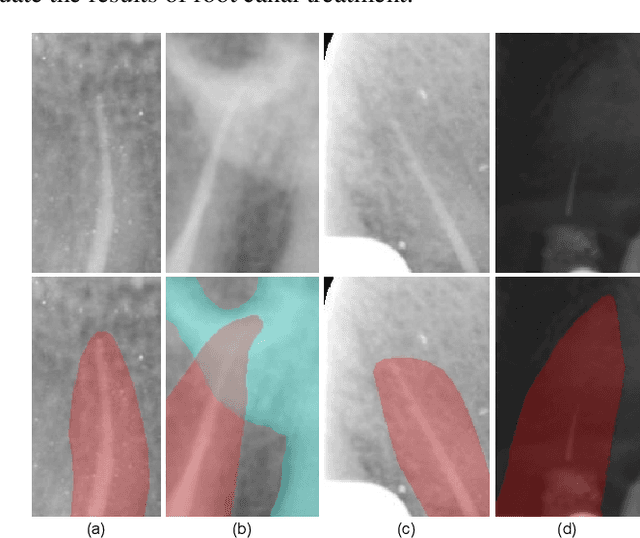

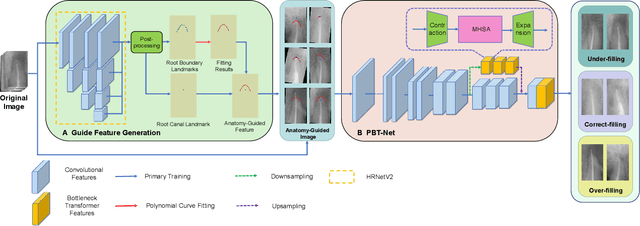

Abstract:Objective: Accurate evaluation of the root canal filling result in X-ray image is a significant step for the root canal therapy, which is based on the relative position between the apical area boundary of tooth root and the top of filled gutta-percha in root canal as well as the shape of the tooth root and so on to classify the result as correct-filling, under-filling or over-filling. Methods: We propose a novel anatomy-guided Transformer diagnosis network. For obtaining accurate anatomy-guided features, a polynomial curve fitting segmentation is proposed to segment the fuzzy boundary. And a Parallel Bottleneck Transformer network (PBT-Net) is introduced as the classification network for the final evaluation. Results, and conclusion: Our numerical experiments show that our anatomy-guided PBT-Net improves the accuracy from 40\% to 85\% relative to the baseline classification network. Comparing with the SOTA segmentation network indicates that the ASD is significantly reduced by 30.3\% through our fitting segmentation. Significance: Polynomial curve fitting segmentation has a great segmentation effect for extremely fuzzy boundaries. The prior knowledge guided classification network is suitable for the evaluation of root canal therapy greatly. And the new proposed Parallel Bottleneck Transformer for realizing self-attention is general in design, facilitating a broad use in most backbone networks.
High-Resolution Segmentation of Tooth Root Fuzzy Edge Based on Polynomial Curve Fitting with Landmark Detection
Mar 07, 2021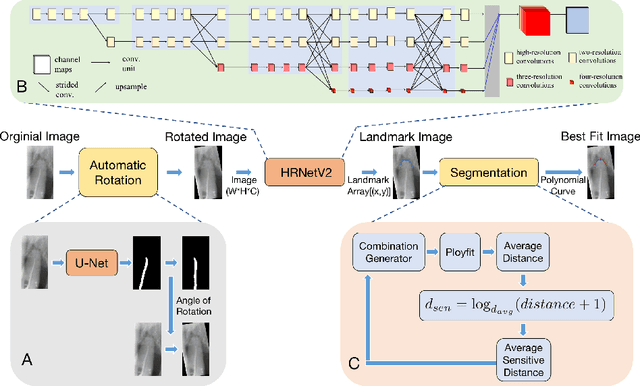

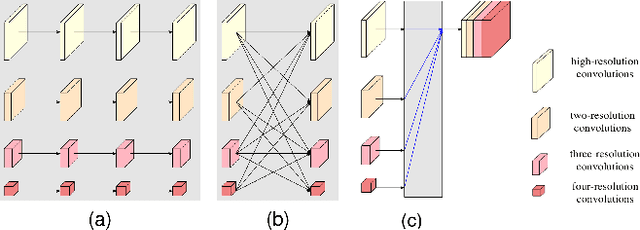
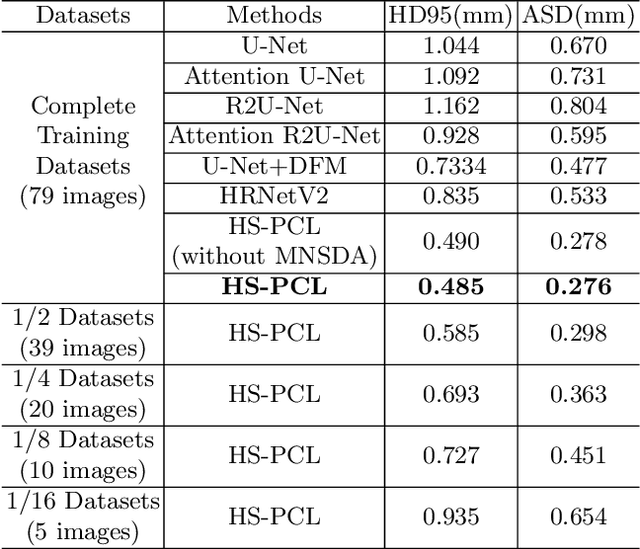
Abstract:As the most economical and routine auxiliary examination in the diagnosis of root canal treatment, oral X-ray has been widely used by stomatologists. It is still challenging to segment the tooth root with a blurry boundary for the traditional image segmentation method. To this end, we propose a model for high-resolution segmentation based on polynomial curve fitting with landmark detection (HS-PCL). It is based on detecting multiple landmarks evenly distributed on the edge of the tooth root to fit a smooth polynomial curve as the segmentation of the tooth root, thereby solving the problem of fuzzy edge. In our model, a maximum number of the shortest distances algorithm (MNSDA) is proposed to automatically reduce the negative influence of the wrong landmarks which are detected incorrectly and deviate from the tooth root on the fitting result. Our numerical experiments demonstrate that the proposed approach not only reduces Hausdorff95 (HD95) by 33.9% and Average Surface Distance (ASD) by 42.1% compared with the state-of-the-art method, but it also achieves excellent results on the minute quantity of datasets, which greatly improves the feasibility of automatic root canal therapy evaluation by medical image computing.
 Add to Chrome
Add to Chrome Add to Firefox
Add to Firefox Add to Edge
Add to Edge